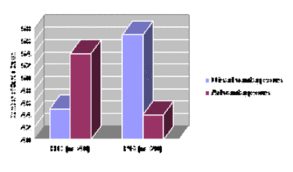The WAGER Vol. 7(43) – Hit or Stay: Decision-Making and the Pathological Gambler
Research suggests that decision-making behavior is impaired among patients diagnosed with ventromedial prefrontal cortex lesions (e.g., Bechara et al., 1994; Bechara et al., 1998; Adolphs et al., 2000; Grant et al., 2000). This research indicates that depleted levels of serotonin might distort an individual’s ability to weigh immediate rewards against long-term negative consequences. Using a specially designed “Gambling Task,” Cavedini, Riboldi, Keller, D’Annucci, and Bellodi (2002) compared decision-making behaviors mediated by the ventromedial prefrontal cortex in pathological gamblers and non-pathological controls. This week’s WAGER considers the results of this study.
Cavedini et al. recruited 20 pathological gamblers and 40 healthy controls through the Department of Neuropsychiatric Sciences at San Raffaele Hospital, Vita-Salute San Raffaele University in Milan. The researchers determined gambling health status using DSM-IV criteria and the South Oaks Gambling Screen (SOGS; Lesieur & Bloom, 1987). Study participants completed the Gambling Task, developed by Bechara et al. (1994). This task is a profit-maximizing exercise involving a series of card selections from four decks, labeled A, B, C, and D. Depending on the card drawn, subjects are either rewarded with money or asked to pay a penalty. Decks A and B are “disadvantageous” decks with large payouts but even larger penalties; subjects who continually choose from these decks will end up behind in the long run. Decks C and D are “advantageous” decks. Although these decks have smaller payoffs, they also have fewer penalty cards; subjects who continually choose from decks C and D will end up ahead in the long run. Cavedini et al. gave subjects $2,000 in play money and asked them to maximize their profits by selecting 100 cards from any of the decks.
Upon completion of the Gambling Task, the study used the Wisconsin Card Sorting Test (Bergh, 1948) and Weigl’s Sorting Test (De Renzi E., Faglioni, P., Savoiardo, M., & Vignolo, L.A., 1966; Weigl, 1941) to assess basic cognitive functioning (e.g., strategy formulation, sorting skills) among both control subjects and pathological gamblers. Cavedini et al. found no differences between PGs’ and controls’ neuropsychological performance in decision-making behaviors unrelated to long-term outcomes. For the Gambling Task, however, pathological gamblers selected more cards from the “disadvantageous” decks and control subjects made more selections from the “advantageous” decks [F(1,58) = 21.79, p = .00002].
Figure 1. Card Selection (Disadvantageous vs. Advantageous) Among Healthy Control (HC) and Pathological Gambling (PG) Patients (Cavedini et al., 2002)
The authors noted that the performance of pathological gamblers was similar to the decision making behaviors of alcohol and drug addicts and obsessive-compulsive patients. This suggestion reinforces the idea that a link may exist between pathological gamblers and others exhibiting impaired frontal cortex functionality. Such a link, if positively established, could provide various opportunities for new treatment strategies for pathological gamblers.
Although the authors suggested that these findings demonstrate the neurological similarities between PG, OCD, and drug addiction, their research is weakened by a noteworthy methodological limitation. While established literature considers the Gambling Task a reliable tool for the evaluation of ventromedial prefrontal cortex activity in drug dependent and obsessive-compulsive patients, it is questionable whether the Gambling Task can assess the behavior of PGs. Because PGs exhibit unhealthy gambling behaviors by definition, it might be expected from the outset that PGs will perform the Gambling Task poorly. Consequently, a poor score in the Gambling Task does not necessarily indicate diminished ventromedial prefrontal cortex function in the problem gambler—it might merely provide additional evidence that PGs cannot gamble responsibly. More telling would have been the use of a non-gambling ventromedial prefrontal cortex challenge to assess decision making behaviors in PGs. Such a task, if performed poorly, might then provide compelling evidence of diminished prefrontal cortex function in PGs.
Despite these concerns, this research is important because it draws significant attention to the decision-making processes of pathological gamblers. Understanding the neurological limitations that might plague pathological gamblers is important not only to researchers who wish to fully understand pathological gambling, but also to treatment providers interested in developing effective and lasting treatment approaches. Historically, research has focused on the social, environmental, and psychological factors related to PG; further research addressing the biological links between neurology and maladaptive behavior is essential to develop a more comprehensive and precise understanding of PG.
Comments on this article can be addressed to Tony Donato.
References
Adolphs, R., Bechara, A., Kaufman, O., Kawasaky, H., Bakken H., Damasio, H., et al. (2000). Single unit responses in human orbitofrontal cortex: Decision making on a gambling task. Journal of Cognitive Neuroscience, 53(suppl), 57B.
Bechara, A., Damasio, A.R., & Anderson, S.W. (1994). Insensitivity to future consequences following damage to human prefrontal cortex. Cognition, 50, 7-15.
Bechara, A., Damasio, A.R., Tranel, D., & Anderson, S.W. (1998). Dissociation of working memory from decision making within the human prefrontal cortex. Journal of Neuroscience, 19, 5473-5481.
Bergh, E.A. (1948). A simple objective technique for measuring flexibility in thinking. Journal of General Psychology, 39, 15-22.
Cavedini, P., Riboldi, G., Keller, R., D’Annucci, A., & Bellodi, L. (2002). Frontal lobe dysfunction in pathological gambling patients. Biological Psychiatry, 51, 334-341.
De Renzi, E., Faglioni, P., Savoiardo, M., & Vignolo, L.A. (1966). The influence of aphasia of hemisphere side of the cerebral lesion on abstract thinking. Cortex, 2, 399-420.
Grant, S., Contoreggi, C., London, E.D., (2000). Drug abusers show impaired performance in a laboratory test of decision making. Neuropsychologia, 38, 11801187.
Lesieur, H.R., Blume, S.B. (1987). The south oaks gambling screen (SOGS): A new instrument for the identification of pathological gamblers. American Journal of Psychiatry, 144, 1184-1188.
Weigl, E. (1941). On the psychology of so-called process of abstraction. Journal of Abnormal Social Psychology, 36, 3-33.
